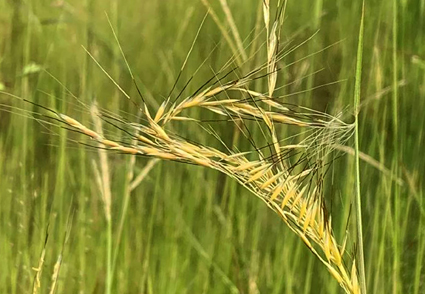Abstract
Dimeria anandibaiana, a new species of Poaceae, is described and illustrated from the Konkan region of Maharashtra. The new species is morphologically allied to D. stapfiana C. E. Hubb. ex. Pilg. A detailed description of the new species, along with a comparative analysis of allied species, coloured photographs, illustration, distribution, and ecological notes, are provided in this paper.
References
- Bhide R.K. (1912) New and Revised species of Gramineae from Bombay. The journal of the Asiatic Society of Bengal 7: 513–520.
- Brown, R. (1810) Prodromus florae Novae Hollandiae et Insulae van-Diemen, Vol. 1. J. Johnson & Co., London, viii + 145–590 pp. https://doi.org/10.5962/bhl.title.3678
- Clayton, W.D. & Renvoize, S.A. (1986) Genera Graminum: Grasses of the World. [Additional Series 13.] Kew Bulletin, Her Majesty’s Stationery Office, London, 389 pp.
- IUCN Red List Guidelines (2024) Guidelines for using the IUCN Red List Categories and criteria, Version 16. Prepared by the Standards and Petitions Committee of the IUCN Species Survival Commission. Available from: http://www.iucnredlist.org/documents/Red List Guidelines.pdf (accessed 6 April 2024)
- Kellogg, E.A. (2015) VIII Panicoideae Link (1827) In: Kubitzki, K. (Ed.) Flowering Plants. Monocots. Springer International Publishing, Switzerland, pp. 301–302. https://doi.org/10.1007/978-3-319-15332-2_22
- Linnaeus C. (1753) Species Plantarum, 1. Junk, London, 282 pp.
- Miquel, F.A.W. (1851) Nieuwe Verhandelingen van de Eerste Klasse van het Koninklijke Nederlandsche Instituut van Wetenschappen te. ser. 3, 4. Amsterdam, Amsterdam, 30 pp.
- Nagaraju, S., Kumari, P., Vivek, C.P., Kothareddy, P.A.A., Kabeer, K., Chorghe, A.R., Chowdhury, S.D., Lakra, R., Bhadra, R. & Prasanna, P.V. (2023) Endemic Grasses of India. Nelumbo 65 (1): 281–282.
- Ohashi, H. (1973) The Asiatic Species of Desmodium: A Review, 1. Ginkgoana, 290 pp.
- Prasanna, P.V., Chowdhury, S.D., Arumugam, S., Vivek, C.P., Chorghe, A., Sitrishna, K., Prasad, K. Poaceae (Gramineae) in Mao, A.A. & Dash, S.S. (Eds.) (2020) Flowering Plants of India- An Annotated Checklist (Monocotyledons). Botanical Survey of India, Kolkata, pp. 355–358.
- Roemer, J.J. & Schultes, J.A. (1817) Caroli a Linne Equitis Systema vegetabilium. Stuttgardtiae, 836 pp.
- Salunkhe, C.B. & Potdar, G.G. (2004) Eulalia shrirangii, a New Species of Poaceae from India. Kew Bulletin 59 (4): 625–627. https://doi.org/10.2307/4110924
- Steudel, E.G. (1855) Synopsis Plantarum Glumacearum, 2 (8–9). J.B. Metzler, Stuttgartiae, 148 pp. https://doi.org/10.5962/bhl.title.471
- Roxburgh, W. (1820) Hortus Bengalensis, or a Catalogue of the Plants Growing in the Hounourable East India Company’s Botanical Garden at Calcutta. Serampore, 277 pp.


